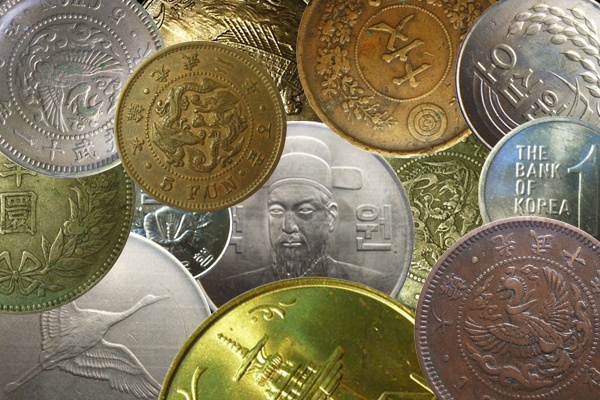

From personal collection
Reference from 2008 Korean Coins and Banknotes Catalogue (Hwadong), JNDA 06 edition, Krause 06 edition. Please kindly buy a copy of either reference to look up the values. I personally recommend the catalogue by Hwadong.
Any questions or enquiry - mail to:
![]()
Korea under Japanese Protectorate
Korea under Japanese Protectorate
Mints under Japanese Protectorate:
1888
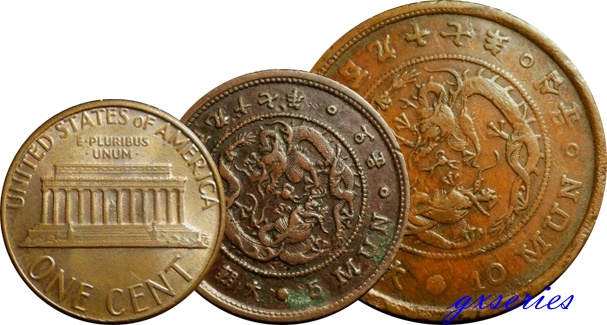
Struck in Gyeonseong (Seoul), various trial coins were first struck in 1884 with Japanese technicians and in 1886 with the aid of German technicians. Mint equipments were imported from Germany. German technicians were soon proving to be too expensive and were replaced with mint employees from Osaka Mint in 1887. Three type of coins were struck: 5 mun, 10mun in copper and 1 warn in silver. While mintage figures for the 5 and 10 muns were not published, the total value of the coins struck around 2,800 warn. It is known that 1,300 of silver warns were struck. By working the maths out, it is estimated that about a mere 10,000 (!) of both coins were struck. These coins were not well received by the public and soon were culled from circulation.
For more information, please read
https://issuu.com/jeandigitala1/docs/the_eleventh_issue_of_jean Pg 46 - 54
1892 - 1896
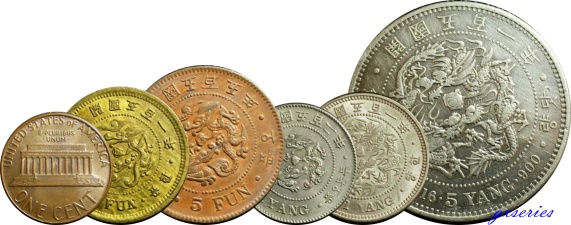
In 1892, a new mint was setup in Incheon as it was closer to the port which led to the old mint in Seoul to be demolished. Machinery and raw materials were imported from Japan. Previously planchets were imported from overseas however the Incheon Mint had the capability to smelt and create planchets. Mint technical staff remained to be Japanese.
While there is no mintage figures available from this era, an interesting fact came about it's minting capability. From Bank of Korea book 1970:
"At first, the nine Japanese printing machines, accepted by the Chonhwankuk had a capacity of turning out 200,000 five fun copper coins with 10 hour operation per day, and it maintained a working staff of 30 persons. However, due to financial difficulty and the lack of technology in operation the Chonhwankuk had to discontinue the production of imprinted coins"
There were significant issues with these coins as many things did not go to plan:
1) 5 yang coins could not be struck in sufficient quantities, only 19,923 were struck
2) Coins were first struck in 4 Dec 1892 but were only released on 20 Aug 1894 (!) This is mainly due to the Chinese warlord, Yuan Shi Kai, objection of the word "Great Korea". As a result coins of 1893 and 1894 did not have such word. Only after did the Chinese were involved with the Japanese in the Sino-Japanese war and lost did the mint release coins of both "Great Korea" and "Korea".
3) The value of nickel fell drastically and therefore the production of nickel copper coins were very profitable which led to the rise of counterfeits. As a result, this led to the public distrust of such coins which led to it's early demonetization.
4) Operation rights were transferred from Japan to Korea in 1893 and was doomed to fail - there was still lack of technology and operational funds. Mint was also proved to be too small and an expansion was required
5) In 1895, the Government promoted Incheon Mint to be expanded, only to be stopped in 1898 by the King as he desired the mint operation to be taken closer to the city.
1898 - 1902
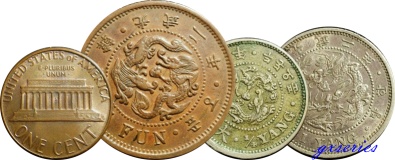
A change in the era's name which King Kojong chose led a very limited amount of coins in this era. Most coins were struck in 1898. Nickel copper 1/4 yang was the biggest offender as it was the most profitable to produce and had plenty of counterfeits as well. Because the amount of counterfeits became uncontrollable, the government declared them to be legal tender (bad move), which led to a huge distrust in public.
The timing of relocating Incheon Mint to Yongsan Mint could not have come any worse as the King desired the mint operation to be taken closer to the city. The Seoul-Incheon railroad was proposed to be built in 1899 which would allow coins to be transported at a wider distance. This rail, Gyeonjin line opened in Sep 18 1899. Yongsan Mint opened after much struggle and conflicts on 4 May 1900. Minting equipment was moved to Yongsan in September and nickel copper coins were struck in small quantities. This mint was closed in November 1904 after Japan took the rights of issuing money in Korea.
1905 - 1907
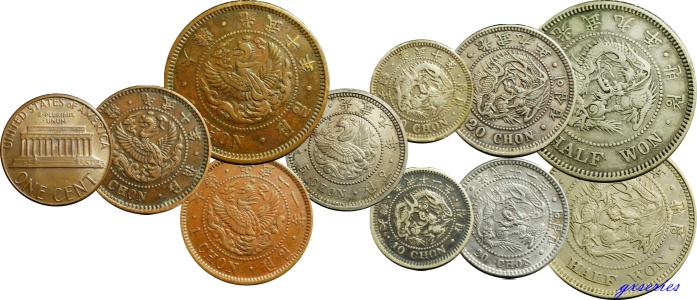
In 1905, Japan started to issue coins for Korea. All coins were struck in Osaka Mint using the same Japanese planchets. As Japan got herself in a war with Russia (Feb 1904 - Sep 1905), coins had to be struck with reduced weight. Hence in 1906 / 1907, coins were released in smaller sizes or lighter weight for 10 chon.
1907 - 1910

In 1908, panic struck with the public as the value of nickel dropped which led to the public exchanging them at the banks. A staggering amount of 266.48 million of nickel copper coins were exchanged. This led to the demonetization of the nickel copper coins in Nov 1908. While supposedly 4 million of 5 chon nickel coins were struck at Osaka Mint in 1909, most were melted down.
Copper coins thankfully did not suffer a panic exchange. Older coins collected from July 1905 to October 1907 resulted to more than 375 tonnes (!). To make numbers easier, assume that only 5 fun coins were collected and they weigh 7 grams. It would mean that more than 53 million (!!!) were collected from circulation.
After the Treaty of Annexation of Korea by Japan was signed on 22 Aug 1910, National Bank of Korea was renamed as Bank of Chosen. Since then, all currency in Korea used Japanese currency.
More interesting article to read
http://www.moneta-coins.com/library/Korea%20-%20A%20Numismatic%20Survey%20-%20Boling.pdf
In Chinese: https://kknews.cc/history/mebnkmg.html
Gaeguk 497, 1888 1 warn (Silver)
 |
|
Gaeguk 497, 1888 10 mun (Copper)
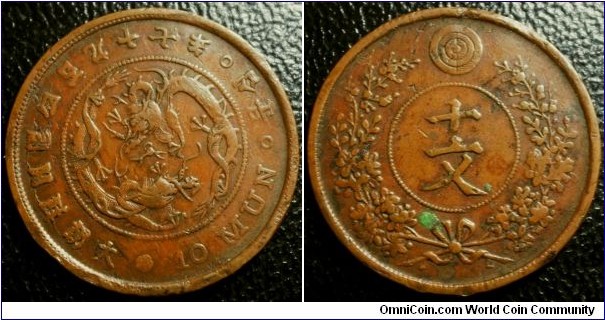 |
|
Gaeguk 497, 1888 5 mun (Copper)
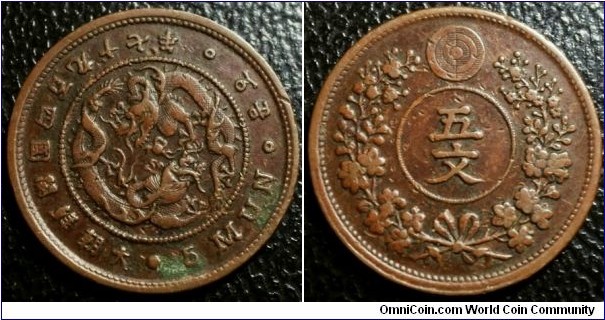 |
|
Gaeguk 501, 1892 5 yang (Silver)
 |
|
Gaeguk 502, 1893 1 whan (Silver)
 |
|
Gaeguk 501,2, Gwangmu 2 (1892, 3, 1898) 1 yang (Silver)
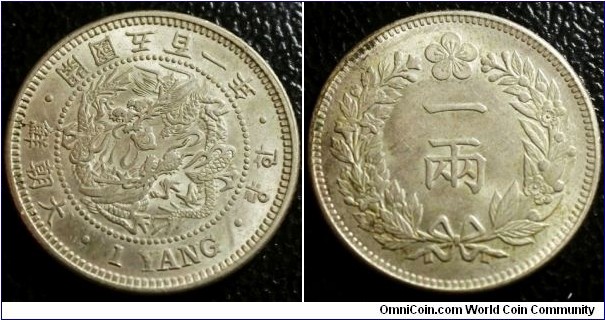 |
|
| Gaeguk 501 (1892) | Gaeguk 502 (1893) | Gwangmu 2 (1898) (narrow yang) |
 |
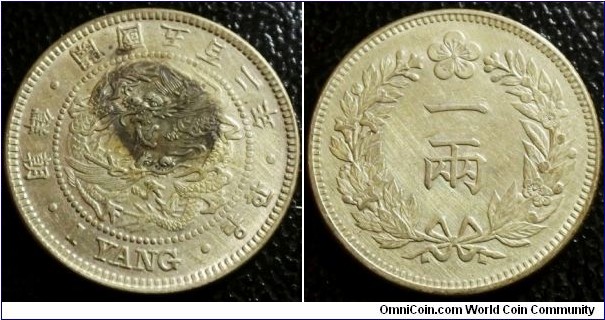 |
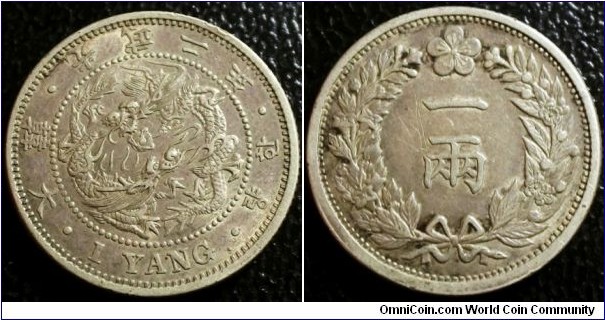 |
| Gwangmu 2 (1898) (wide yang) - key of series | ||
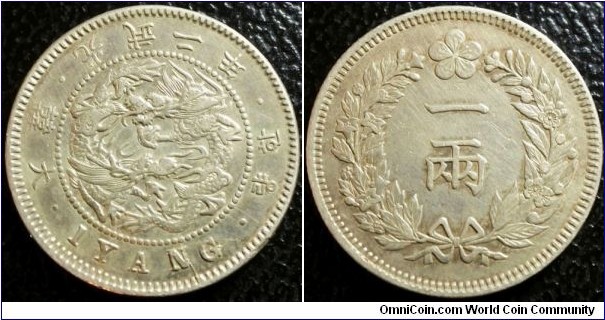 |
Undocumented variety: large 2?
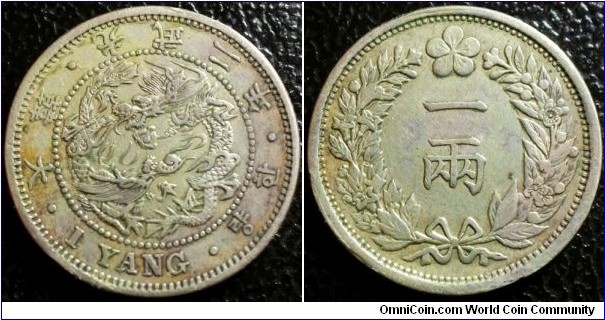
Gaeguk 501-505, Gwangmu 1-5 (1892-1901) 1/4 yang (Nicupro)
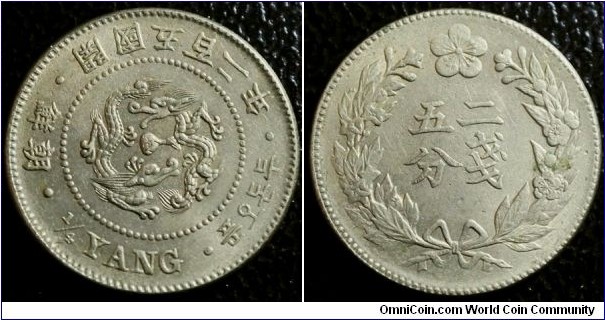 |
|
* extremely difficult
1898 1/4 yang - small font variety? This coin looks legit - perhaps an undocumented variety?
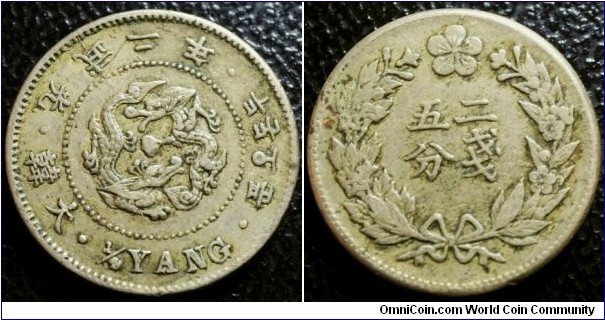
Note that this particular year coin is home to a lot of counterfeits, this being an example
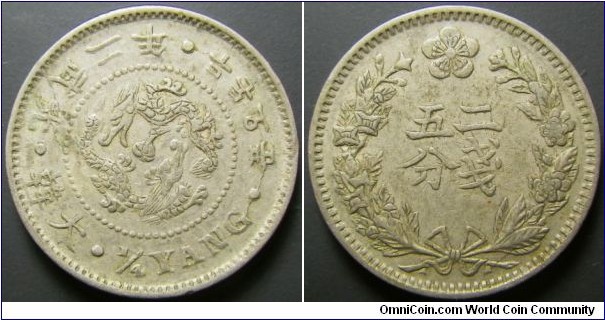
Gaeguk 501-505, Gwangmu 2, 3, 6 (1892-96, 98, 99, 1902) 5 fun (Copper)
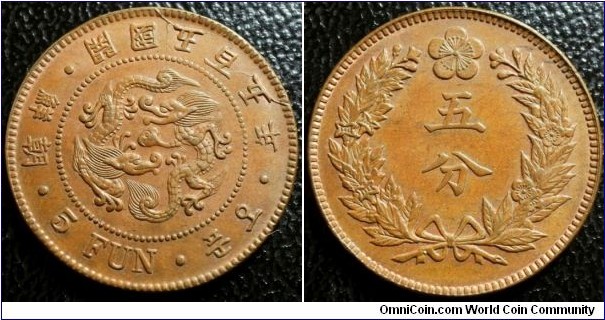 |
|
* Rather scarce to rare
Note: Many Korean 5 fun coins were exported to China and overstruck. These can be found from coins minted at Chekiang and Hupeh. These are mainly around coastal area of China, most likely due to trades that occurred around that time. These are likely non official and privately struck.
| Chekiang (1902-1905) 10 cash overstruck on Korean Guangmu 6 (1902) 5 fun | Hupeh (1903-1906) 10 cash overstruck on Guangmu 2 (1898) 5 fun |
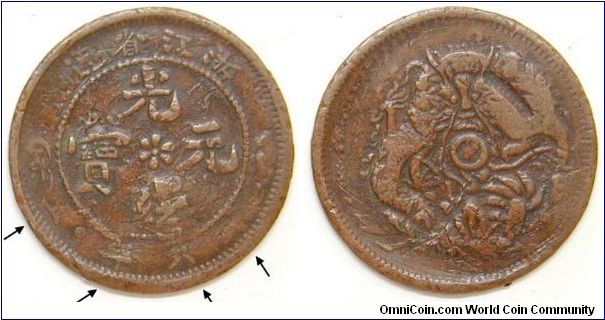 |
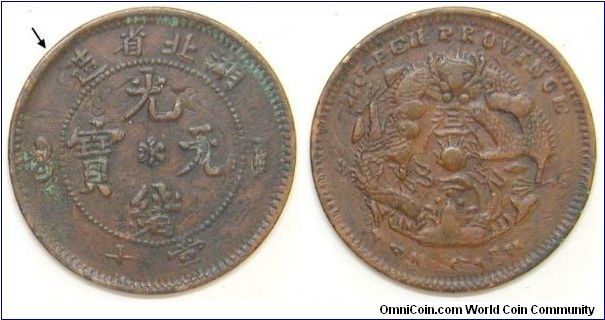 |
(Special thanks to wattwat)
Gaeguk 501,502, 504,505 (1892, 3, 5,6) 1 fun (Brass)
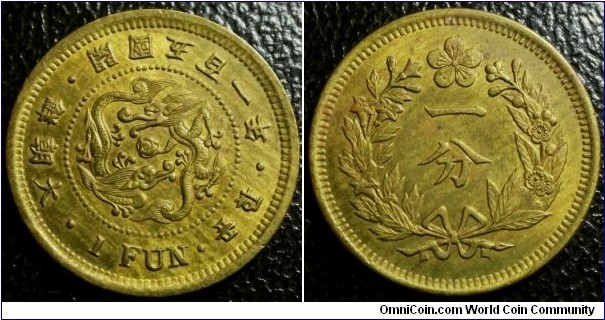 |
|
| Gwangmu 501 (1892) - Great Korea | Gwangmu 502 (1893) - Korea | Gwangmu 504 (1895) - Great Korea |
 |
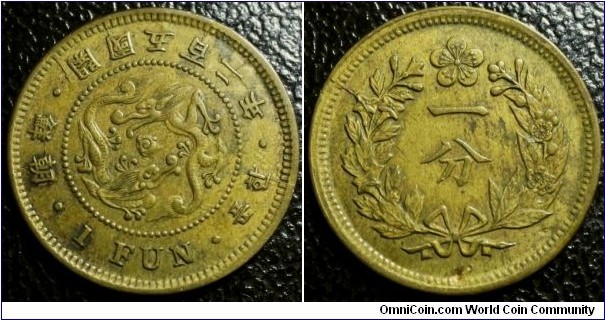 |
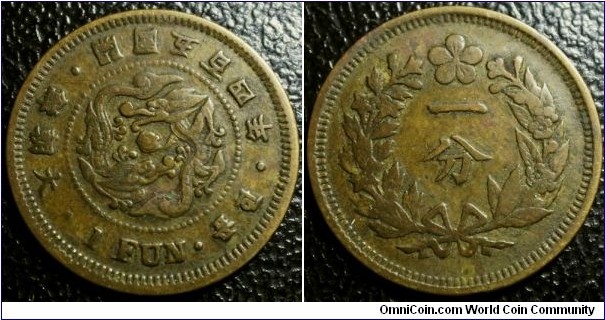 |
| Gwangmu 504 (1895) - Korea | Gwangmu 505 (1896) - Great Korea | |
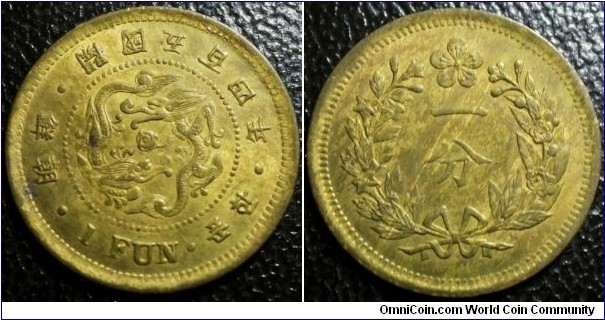 |
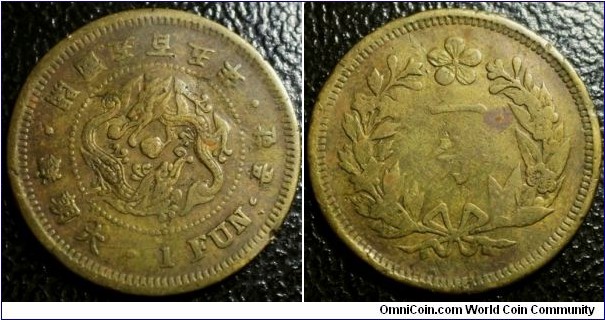 |
1896 1 fun is a surprisingly difficult year to find
20 Won
|
10 Won
|
5 Won
|
Note: All Korean gold coins from this era are extremely rare and expensive as many were melted down.
Gwangmu 9,10 (1905,6) half won (large type) (Silver)
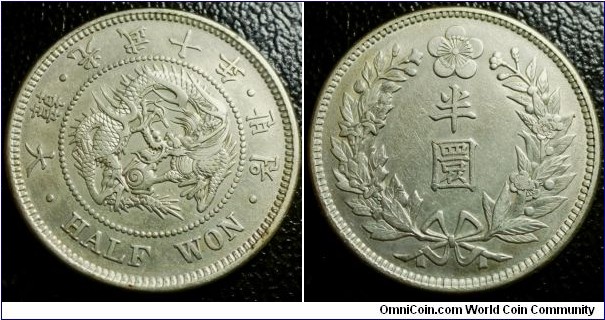 |
|
| Gwangmu 9 (1905) - 0.6m | Gwangmu 10 (1906) - 1.35m (JNDA quotes 1.2m) |
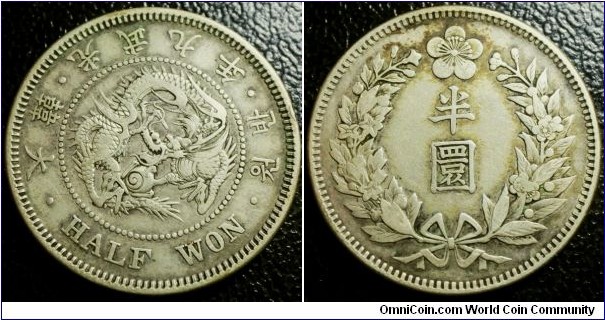 |
 |
Gwangmu 11, Yunghui 2 (1907, 8) half won (small type) (Silver)
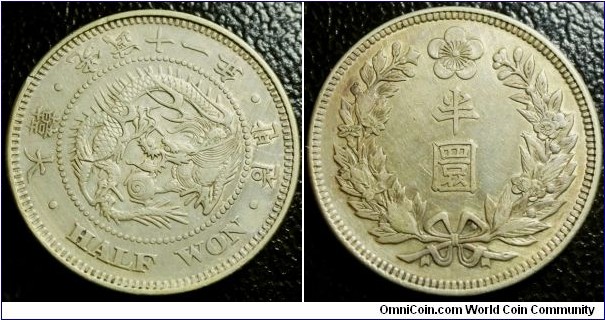 |
|
| Gwangmu 11 (1907) - 1.0m | Yunghui 2 (1908) - 1.4m |
 |
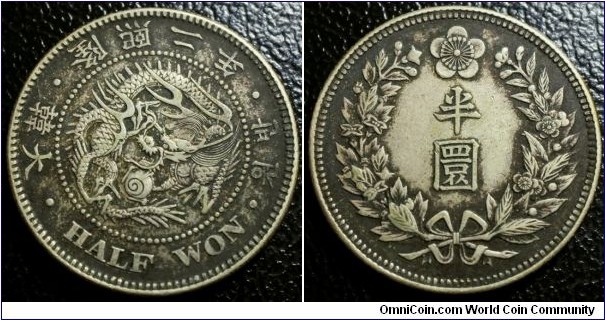 |
Gwangmu 9, Gwangmu 10 (1905, 6) 20 chon (large type) (Silver)
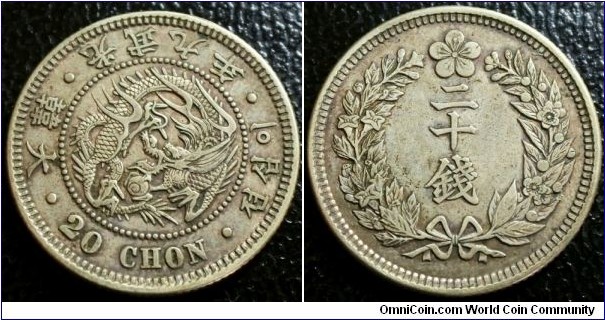 |
|
| Gwangmu 9 (1905) - 1.0m | Gwangmu 10 (1906) - 2.5m |
 |
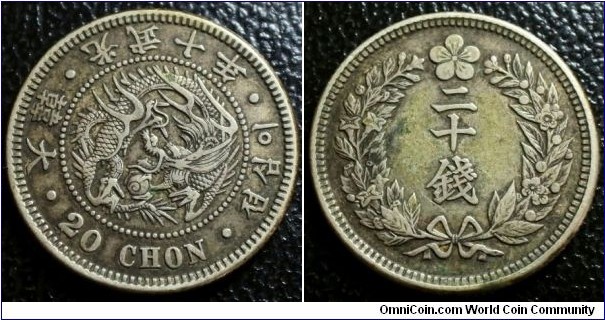 |
Gwangmu 11, Yunghui 2-4 (1907, 8-10) 20 chon (small type) (Silver)
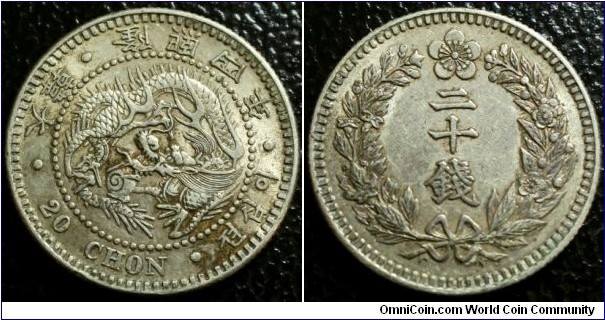 |
|
| Gwangmu 11 (1907) - 1.5m | Yunghui 2 (1908) - 1.4m (JNDA quotes 3.0m) | Yunghui 3 (1909) - 2m |
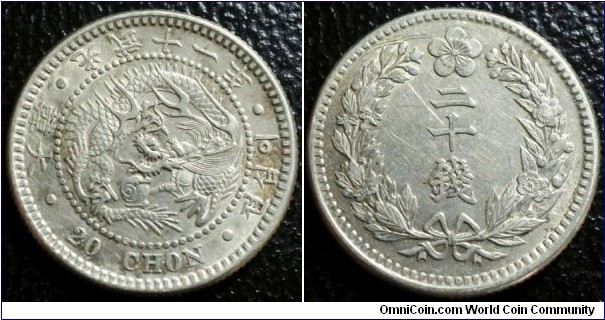 |
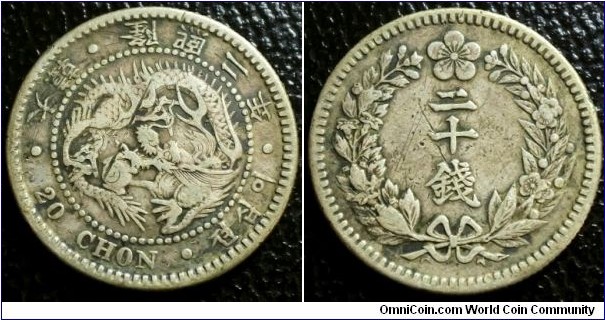 |
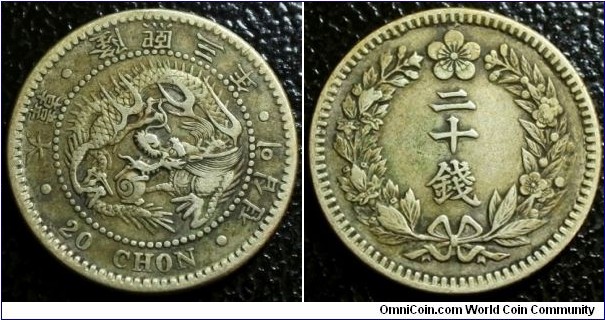 |
| Yunghui 4 (1910) - 2m | ||
 |
Gwangmu 10 (1906) 10 chon (large type) (Silver)
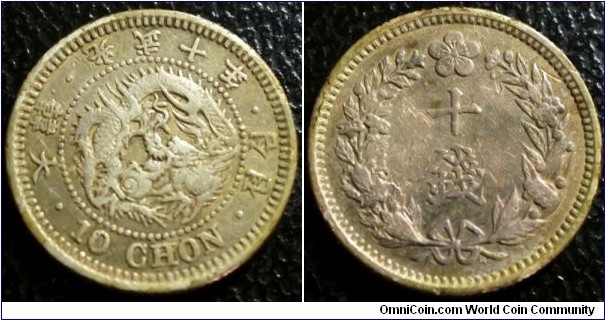 |
|
|
Gwangmu 10 (1906) |
 |
Gwangmu 11, Yunghui 2-4 (1907, 8-10) 10 chon (small type) (Silver)
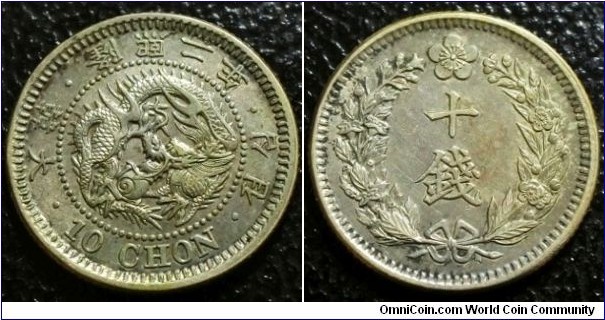 |
|
| Gwangmu 11 (1907) - 2.4m | Yunghui 2 (1908) - 6.3m | Yunghui 4 (1910) - 9.5m |
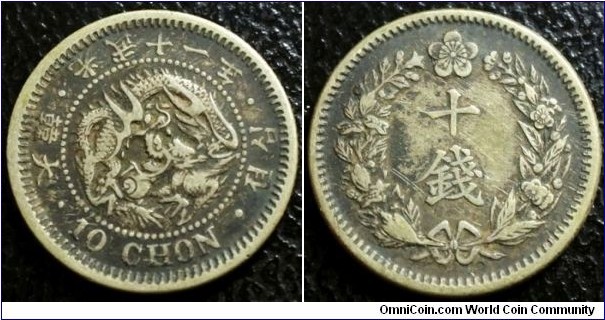 |
 |
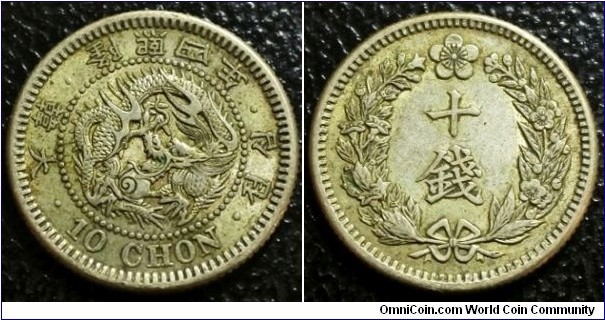 |
Gwangmu 9 ,11, Yunghui 3 (1905, 7, 9) 5 chon (Nicupro)
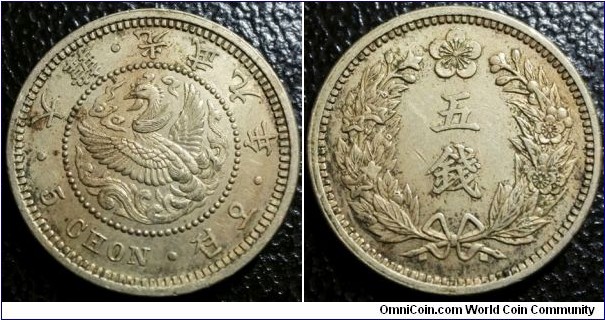 |
|
| Gwangmu 9 (1905) - 20m | Gwangmu 11 (1907) - 16m | Yunghui 3 (1909) - unknown (JNDA quotes 4.0m) |
 |
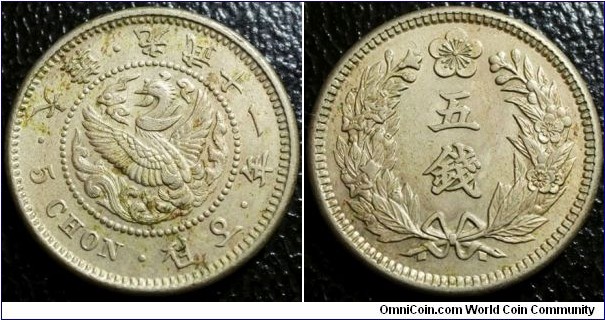 |
 |
Note: JNDA quotes for Yunghui 3 5 chon seems to be awfully high - the price quoted is in at least 1-2 thousands of dollars which meant a fair amount of them must have been melted down later on.
Gwangmu 9,10 (1905,6) 1 chon (large type) (Copper)
 |
|
| Gwangmu 9 (1905) | Gwangmu 10 (1906) |
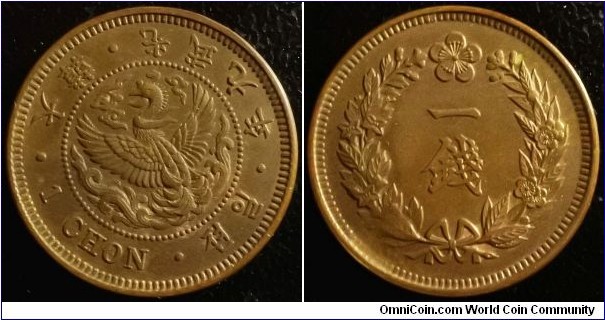 |
 |
Gwangmu 11, Yunghui 1-4 (1907,7-10) 1 chon (small type) (Copper)
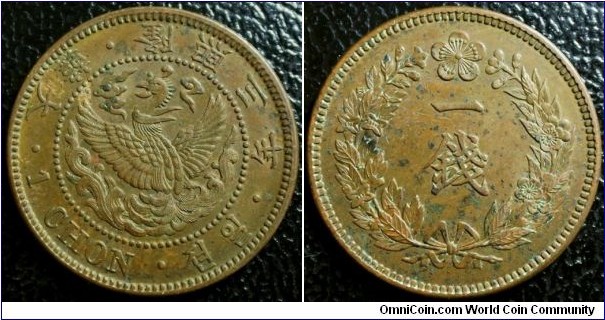 |
|
| Gwangmu 11 (1907) | Yunghui 1(1907) | Yunghui 2 (1908) - 6.8m |
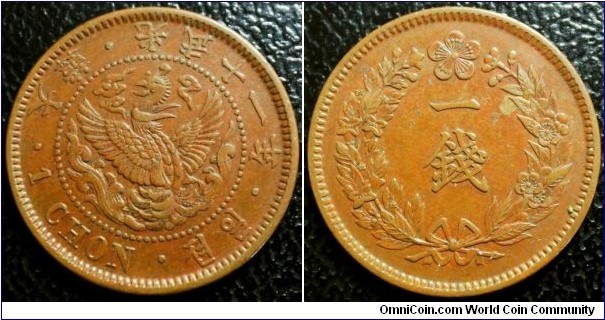 |
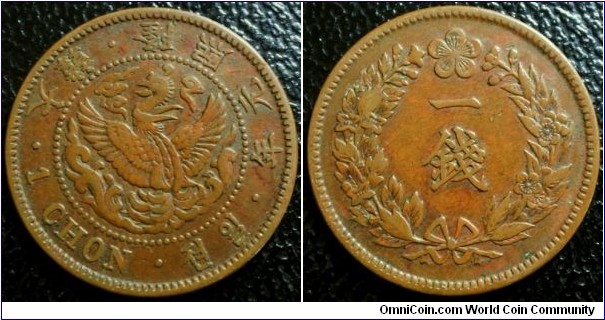 |
 |
| Yunghui 3 (1909) - 9.2m | Yunghui 4 (1910) - 3.5m | |
 |
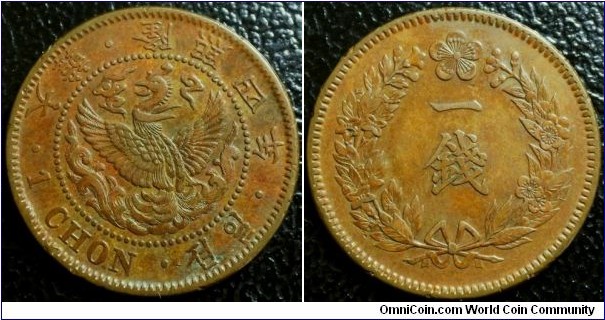 |
Gwangmu 10 (1906) half chon (big type) (Copper)
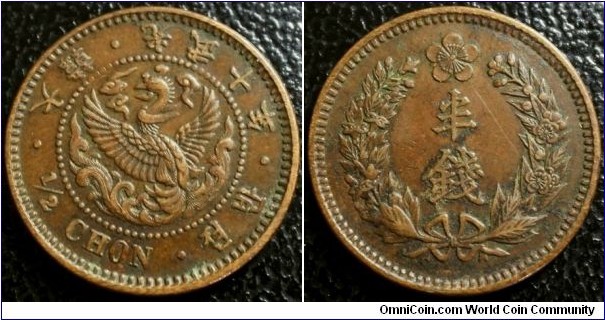 |
|
| Gwangmu 10 (1906) |
 |
Yunghui 1-4 (1907-1910) half chon (small type) (Copper)
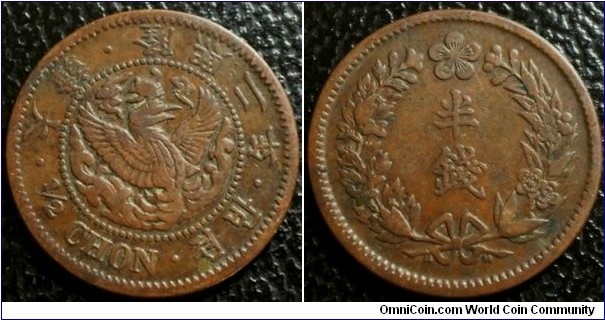 |
|
| Yunghui 1 (1907) - 0.8m | Yunghui 2 (1908) - 21m | Yunghui 3 (1909) - 8.2m |
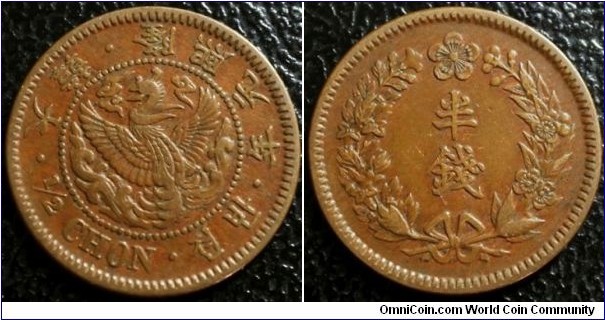 |
 |
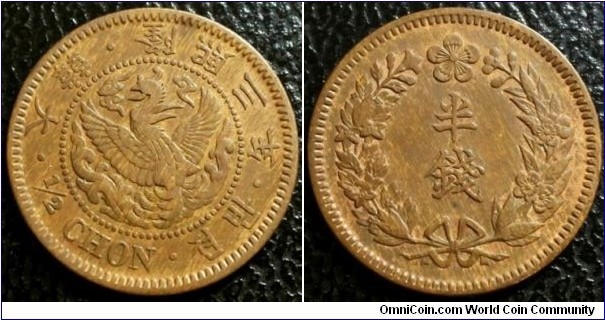 |
| Yunghui 4 (1910) - unknown (rarest) | ||
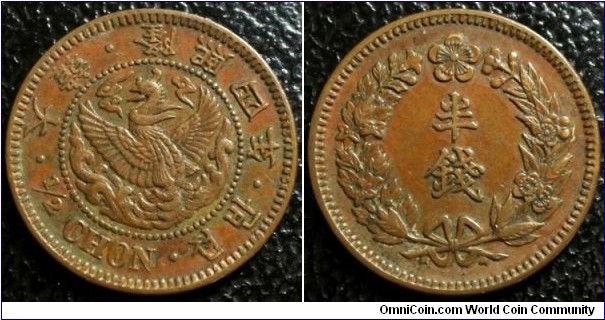 |
Some fun stuff
Note: The size of the Gwangmu 10 1/2 chon (big type) is roughly the same diameter of the Gwangmu 11, Yunghui 1-4 1 chon (small type) - the only major difference is the weight and thickness but this modification must have fooled a fair amount of people. The reverse is modified to show 1 chon. This is NOT an error coin but instead modified to fool people!
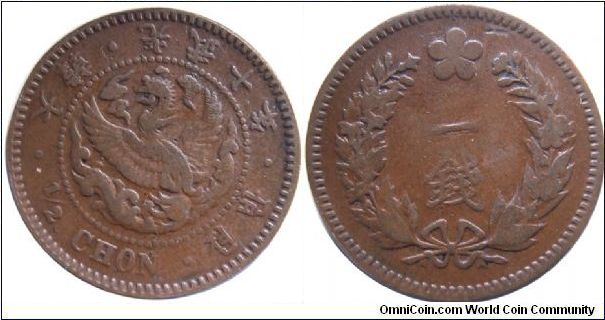
Error coins
Error coins from this era is quite uncommon to rare. Rotated die error is somewhat 'common' in the Imperial Korean error coins.
The way these coins are supposed to aligned are "5 fun" and flipped in coin alignment to Imperial Seal.
| Common coin die alignment | 90 degree rotation error |
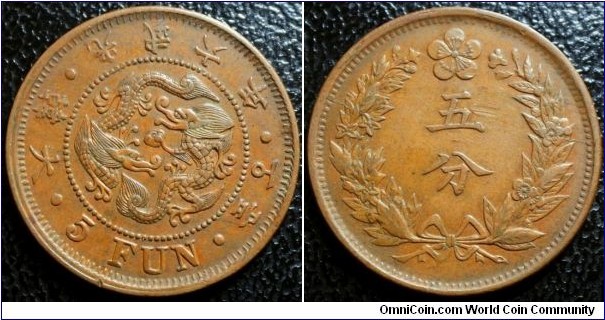 |
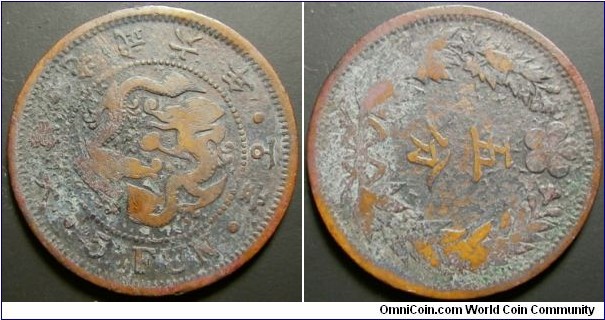 |
This is coin aligned on the "dot" to Imperial seal.
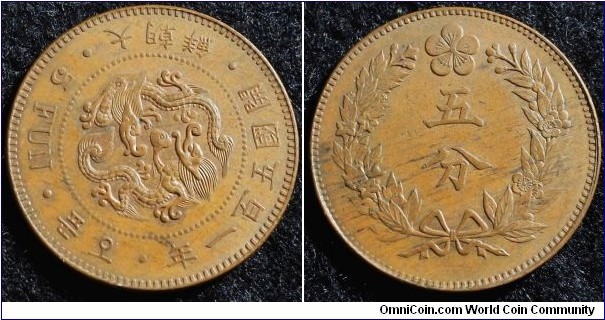
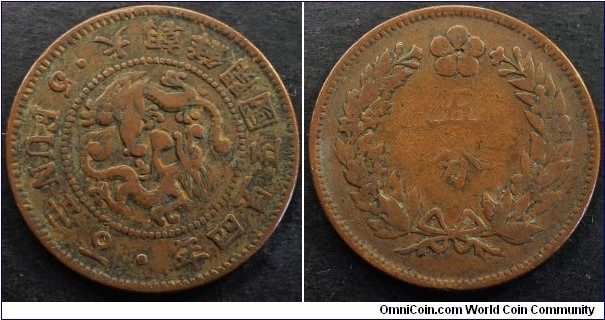
This is medal aligned to the dot to Imperial seal.
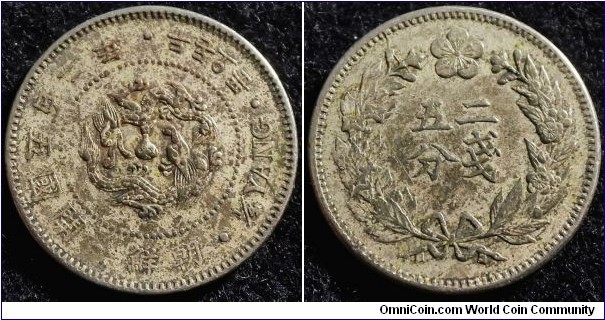
Doubling on the character "hundred"
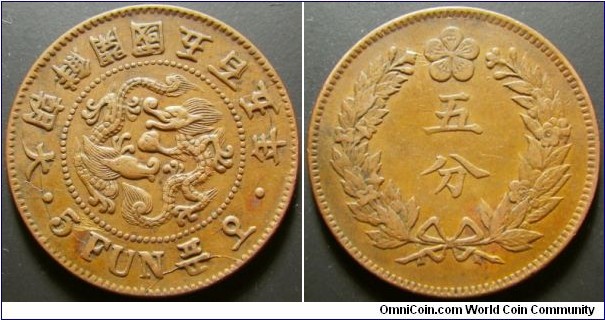
Major die crack like this is not common
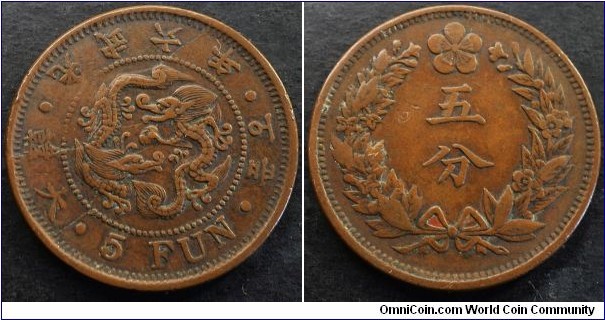
Off centre error coins like this rarely appear in the market!
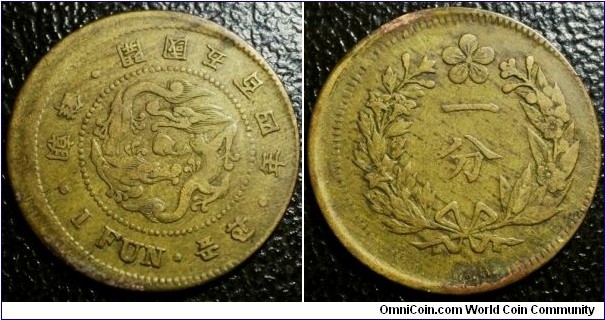
Extremely overweight 5 fun. Overweight at 10.18g vs 6.9g (technical)
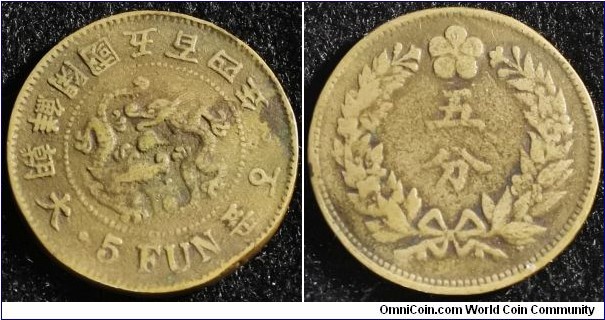
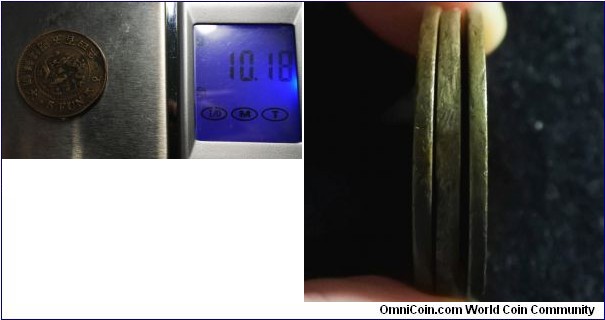
Russo - Korean coinage
In 1898, Russia saw her interests in Korea. Russo-Korea Bank was opened in Korea for about a week in 1899 before it was forced to shut down by the Japanese and British.
3 different types of coins were issued with the date 1901 - 1902 and circulated for a very short period of time.
These would likely been culled in 1905 as the Japanese won the war against the Russians which resulted Korea to be a Japanese Empire protectorate.
These were struck with similar planchets with earlier issues. The origins of where these coins were struck are questioned. These could have been struck in Korea however would be deemed unlikely with the Japanese interests in Korea. At the same note
Coins of this type are very rare and pattern coins exist. A tribute coin was struck in Japan by a private mint in 2000 - mintage of just 1,000.
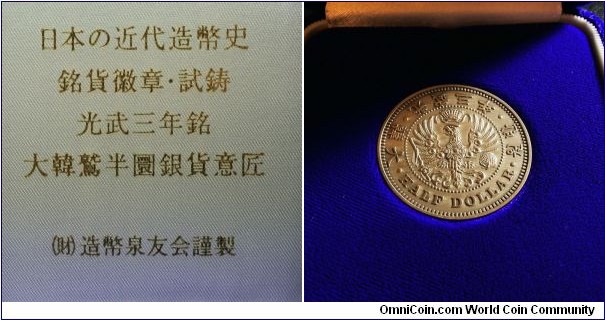
There are a few things to note:
1) Strong Russian influence, imitating the double head eagle featured on many Russian coins.
2) The denomination is dollar instead of won
3) Other than the differences described, design is oddly similar to the existing coinage.
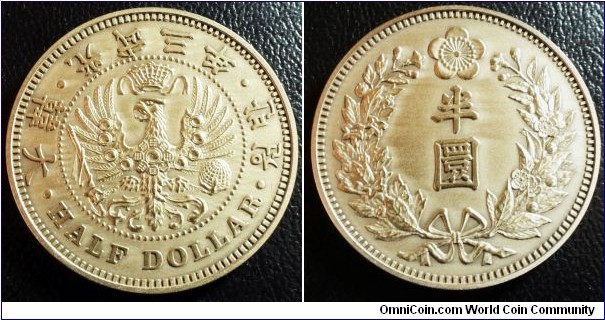
31/03/24